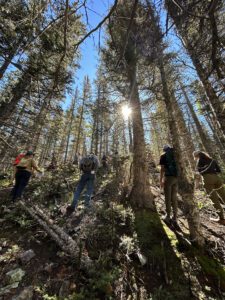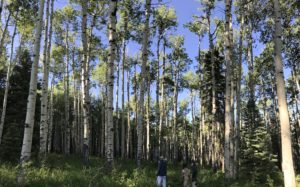By Dr. Alan Barton
NMFWRI Director
The work of NMFWRI naturally involves partnering with many different landowners, those who make decisions about how the forests in the state are managed. And New Mexico is quite possibly the most interesting place in the U.S. to carry out this work, due to the different types of landownerships seen around the state. In much of the U.S., land generally fits into one of two categories: either public, that is, government owned, or private. New Mexico has its share of both types of land, but also includes common property and traditional lands that broaden the cultural richness tied to the land and the management regimes of the state’s landowners.

As with most western states, a large part of New Mexico – nearly 35 percent of all land – is owned by the federal government, incorporating a variety of conservation lands, including five national forests, two national parks, 13 national monuments, nine national wildlife refuges, and four large military bases. The New Mexico state government also owns 9 percent of the state’s lands, and state agencies manage 35 state parks and 37 wildlife management areas as well as state trust lands that generate revenue for public schools and state institutions. Counties and local governments manage parks for recreation and watersheds for municipal water supply. In total, public entities own about 42 percent of all forestland in the state.
Forested land in New Mexico is also held by the state’s 23 sovereign tribal entities, including the Navajo Nation, the Mescalero, Jicarilla and Fort Sill Apache tribes, and 19 Pueblos. Many of these have their own natural resources departments to manage their forests, water and rangelands. The Bureau of Indian Affairs, the oldest land management agency in the U.S., has six agency offices in New Mexico, with trained foresters who work with tribal natural resource professionals on forest management. Tribal lands are largely reserved federal lands, but the reservations are not public lands and are under the control of the tribal governments.
Private ownerships encompass 58 percent of New Mexico’s forests. Most private forestland is held in small parcels by individuals and families, who use their forests for recreation or income generation. Forests also cover a few large ranches around the state, including the Philmont Scout Ranch that hosts Boy Scouts from around the U.S. each summer, and the Vermejo Park Ranch, owned by businessman Ted Turner. A much smaller portion of the state’s forests are owned by land trusts that preserve wildlands, and businesses, including forest industry.
 New Mexico is also home to traditional lands that pre-date statehood, including 35 active communally owned land grants (mercedes), covering 200,000 acres. In general statistics, some of these may be counted as private lands, and some as public lands, as many land grant governments are political subdivisions of the state. But a large portion of these lands and resources are owned and managed as common property, with access and benefits shared by an entire community. Dedicated common property systems are a normal form of ownership in many countries, but common property is rare in the United States. The mercedes in New Mexico date back to the days of Spanish and Mexican rule (1692–1846), and the 1848 Treaty of Gudalupe Hidalgo, that established U.S. sovereignty over most of New Mexico, recognized and validated the traditional property from the previous regimes, including over 150 communal land grants. However, subsequent adjudications of these lands carried out by the U.S. government reduced the common landholdings and number of recognized land grants. Yet, these common properties endure today throughout the state, and taken together, they include a substantial amount of community-held forestland.
New Mexico is also home to traditional lands that pre-date statehood, including 35 active communally owned land grants (mercedes), covering 200,000 acres. In general statistics, some of these may be counted as private lands, and some as public lands, as many land grant governments are political subdivisions of the state. But a large portion of these lands and resources are owned and managed as common property, with access and benefits shared by an entire community. Dedicated common property systems are a normal form of ownership in many countries, but common property is rare in the United States. The mercedes in New Mexico date back to the days of Spanish and Mexican rule (1692–1846), and the 1848 Treaty of Gudalupe Hidalgo, that established U.S. sovereignty over most of New Mexico, recognized and validated the traditional property from the previous regimes, including over 150 communal land grants. However, subsequent adjudications of these lands carried out by the U.S. government reduced the common landholdings and number of recognized land grants. Yet, these common properties endure today throughout the state, and taken together, they include a substantial amount of community-held forestland.
NMFWRI works closely with many of the government agencies, private landowner organizations, and traditional groups that engage in collaborative, cross-boundary, large landscape forest management. Our Institute also partners with a variety of other entities that have a stake in public and private lands and contribute to their management. The diverse mix of scientific and traditional forest management practices observed across the state’s landscapes presents unique challenges, and also provides a creative array of ideas and tools that can be adapted and applied for effective outcomes. Over the past 20 years, it has been an honor to work with our diverse partners and contribute to adaptive forest management in New Mexico. And we eagerly look forward to many more fruitful years of collaborative partnerships in our beautiful Land of Enchantment.
